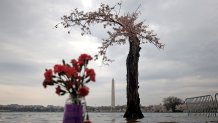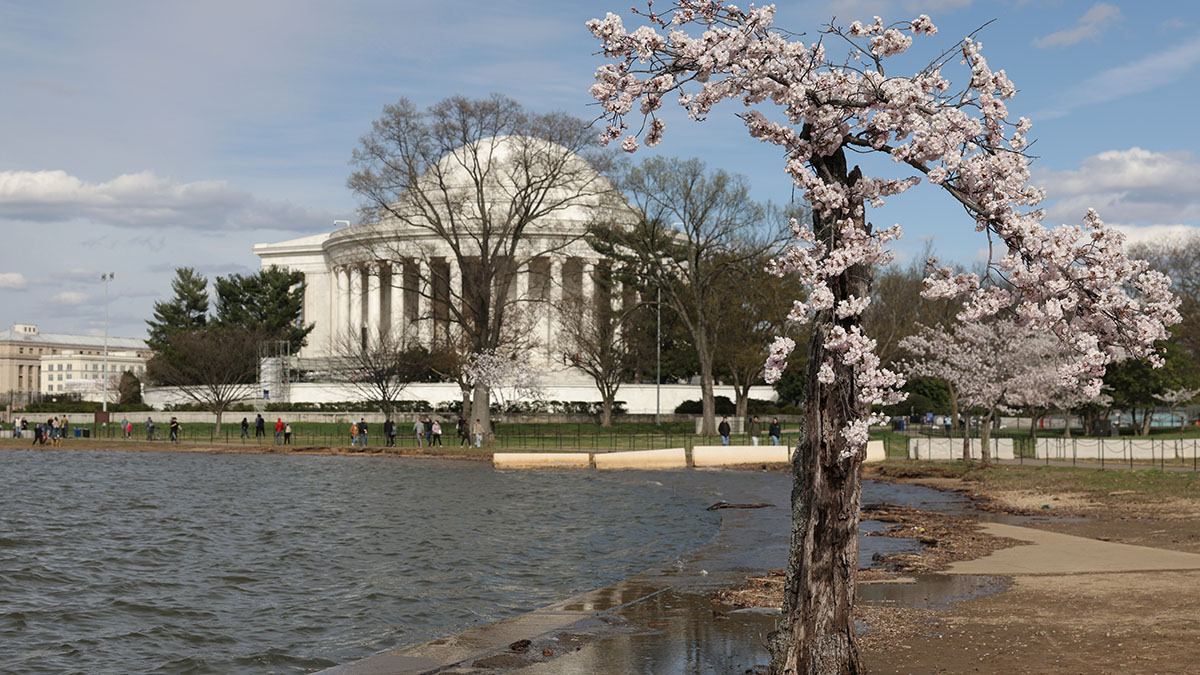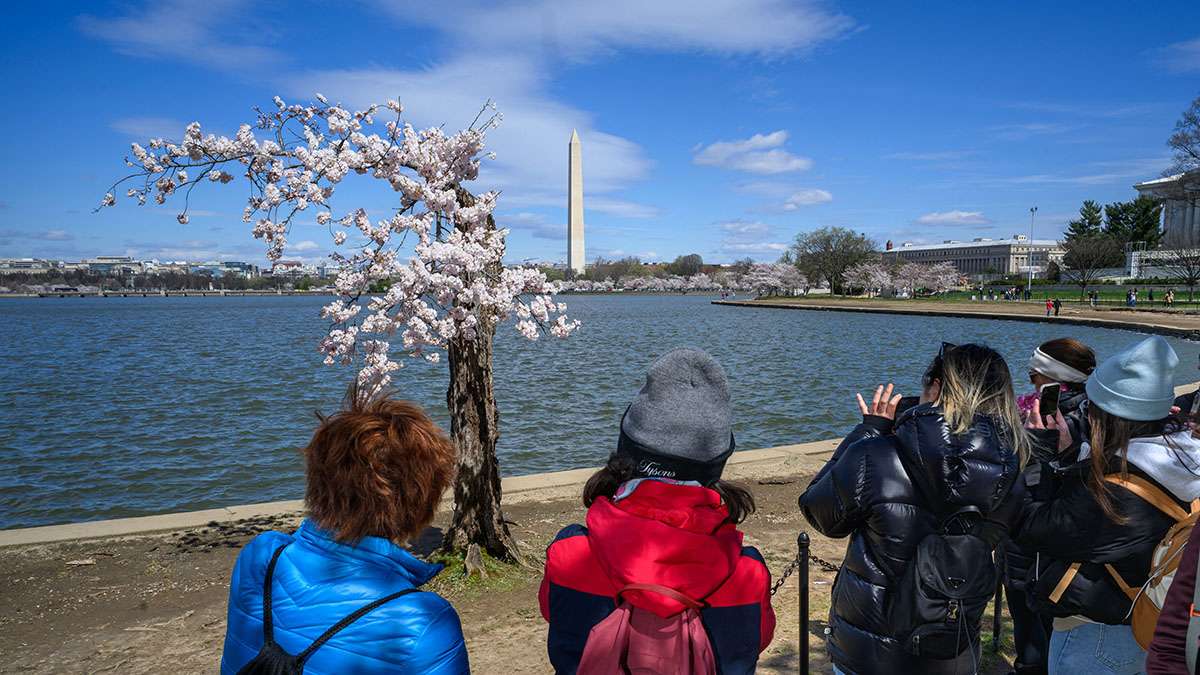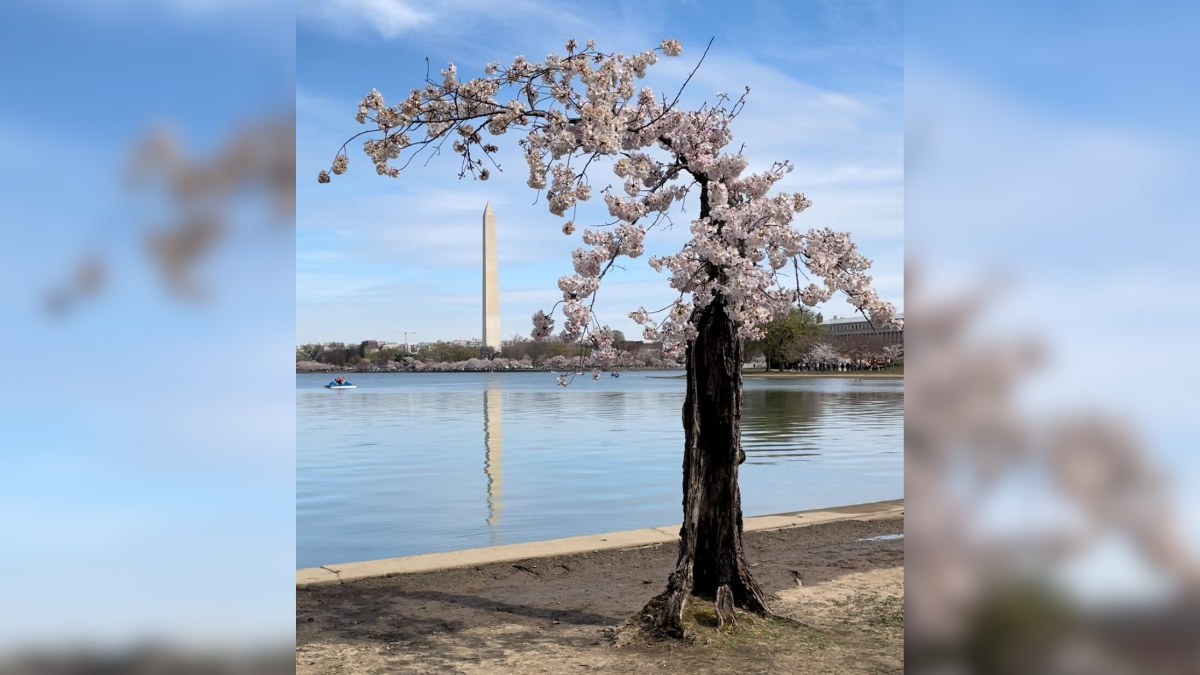After years of blooming despite all odds, the little cherry tree that could ... can't anymore.
Stumpy is dead.
We knew this day was coming: that Stumpy's time with us was coming to a close. The National Park Service gave us plenty of warning during peak bloom, when they told us rehabilitation of the Tidal Basin seawall would require the removal of more than 100 trees, Stumpy included, sometime this spring.
We even knew it made scientific sense. Stumpy's home in the gentle but relentless flooding between the Ohio Drive Bridge and the Jefferson Memorial wasn't a good place for any tree.

"If you look to the left around the bend of the Tidal Basin that goes towards the Jefferson Memorial, there are no trees left there," Mike Litterst, National Park Service spokesperson, told us in March. "Because all of those trees that suffered the same inundation of water died, and were removed several years ago."
Still, Stumpy survived. Until Friday morning, when he became just a stump.
D.C. residents visiting the Tidal Basin mid-morning on Friday were met with an empty space where Stumpy once stood.
That Stumpy survived for so long under hostile conditions is a testament to just how miraculous he was. And we knew he was miraculous going back to 2020, when a Reddit user posted Stumpy's portrait to r/WashingtonDC and said the tree was as dead as his love life.
"Mostly dead, it's slightly alive," responded one commenter, seemingly referencing the famous scene with Miracle Max from the 1987 film "The Princess Bride."
It's a fitting message, and one that summarizes Stumpy well: It's not over until it's over.
That post was made on Feb. 26, 2020 — little more than two weeks before COVID-19 was declared a global pandemic and institutions around the world closed indefinitely.
At a time when we all needed a little hope, it's no surprise that users latched onto Stumpy, posting updates as his few threadbare branches bloomed that spring. If Stumpy could make it through a brutal March 2020, maybe we could, too.
Then he did it again in 2021. And again. And again. And again, despite being essentially just a bark framework, barely transmitting nutrients to the few branches that bloom every spring, "and not much else," according to Litterst.
"There is no interior trunk," Litterst told us in March. "People ask us, 'You know how old that tree is?' There literally aren't any rings for us left to count on the interior of the tree."
A tree, blooming as it should, standing tall and beautiful — that's lovely, but unremarkable.
But a friendly little shard of bark, struggling to live in conditions outside its control, and doing it anyway? That's relatable.

With each successive bloom, Stumpy's fame grew.
By this March, when the NPS announced he would have to go, he was loved enough to inspire marathon mascot costumes, calendars, T-shirts, cards, whiskey tributes and visits from diplomats.
The Japanese embassy posted a photo of their visit during peak bloom: three diplomats, all bowing to show respect to a half-dead tree holding court on the Tidal Basin, with the Washington Monument in the distance.
It's because Stumpy was so ragged that we loved him so much.
A tall tree, blooming as it should, standing beautiful and high above it all — well, that's lovely, but unremarkable. But a friendly little shard of bark, struggling to live in conditions outside its control and hostile to its existence, and doing it anyway? That's relatable.
We are all Stumpy: proof that life can not only continue, but thrive, in a way, when and where it doesn't feel like it should.
But then came the news: The Tidal Basin seawall has to be repaired. That can't happen while the cherry trees in the area remain. And if it's not repaired, the slow sinking of the seawall will kill the trees anyway, and prevent the NPS from planting any more.
But Stumpy could leave behind a legacy of new trees
Before Stumpy was removed, horticulturists from the U.S. National Arboretum were tapped by the NPS to collect clippings from the tree.
The tree experts at the Arboretum's headquarters in D.C. and their satellite location in McMinnville, Tennessee will prep those clippings for propagation.
With the care of determined scientists and the luck of Mother Nature, those clippings will continue growing into baby trees, which — two or three years from now — will be planted back along the Tidal Basin.
"The process takes a long time," Piper Zettel, one of those arboretum horticulturists, told us. "Trees grow very slow. So we need to be patient."
And, a couple more years after that, maybe with the same stubborn spirit that kept Stumpy himself alive, those Stumpy clones will also bloom with beautiful cherry blossoms we can all enjoy.
Stumpy as Stumpy 2.0 won't look the way we knew him in 2024. Those trees will be healthy and will live in along a Tidal Basin free of flooding. The original Stumpy will become mulch, which will decompose and nourish the roots of those children in their new home. (It's possible "The Circle of Life" will play softly in the background during the process ... at least in our minds.)
We were lucky enough to know and love Stumpy the first time around, however brief that was. We all witnessed the unique confluence of circumstances that created his rise to fame and necessitated his end. In the end, even if we can't recognize him, even if he's in a different form entirely, Stumpy will be still there.
What do you do when a symbol of hope and resilience has to go?
The answer, it seems, is more hope, and more resilience. You mourn. You remember, and share stories. You laugh. And then you rebuild.




